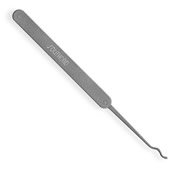Lock Picks
Lock Picks (Types & Applications)
Lock picks come in many shapes and sizes, as well they must. Any locksmith could tell you how difficult it is to pick a lock without a pick of the right size. Different locks require different tools, and a locksmith must stock up on different lock picks in order to be prepared for any emergency. Here are some of the basic types of lock picks you would find in a professional lock picking kit:
Diamond:These picks have a flat “bottom” and a ramp shaped tip similar to one half of a triangle. They come in various sized tips from small to relatively large. The angle of the tip or head may also vary to offer better reach into the back of locks, or to reach around pins/wafers that have already been picked. They are useful for both wafer and pin-tumbler locks, and are especially favored for padlocks. A very common pick used by professionals world-wide.
Single Ball: The tip of these picks are completely round. These are most often used for single sided wafer locks or warded locks that provide enough clearance.
Double Ball: A double ball pick's head shape commonly referred to as a “snowman” pick since the ball nearest the tip is most often found smaller than the one situated close behind it. These picks are most commonly used for bi-direction wafer locks.
Hook: The tip is bent upwards and rounded basically leaving the tip itself with no particular shape. The severity of bend required depends on the particular bitting and warding of the lock being worked on. These picks are best used with pin-tumbler locks and are one of the most common used by professionals.
Key extractor: Some types can often be mixed up with a straight diamond pick if it weren't for the fact that the extractor has a sharp edge to grip the broken key while a regular diamond is less pronounced.
Rake: A rake pick generally has a wavy tip configuration, and the design possibilities are restricted only by imagination
and what has most frequently been used successfully. Rakes are generally manipulation back and forth across the pins in a lock to create
a gap at the sheerline of the lock. In a wafer lock a rake is used to rapidly vibrate the wafers to rest at the sheerline of the lock and allow it
to open. The most common types of rakes are the following:
a.) "C" rake or ¾ rake. Probably the most common of rake picks, this can be used as a short hook pick by using it “tip up” or raking by flipping it over and using the “bumps” in an in-out sawing motion.
b.) "S"-rake has a more severe profile and is best used strictly as a rake. Most success will be found in pin-tumbler locks with a high-low-high or reverse bitting situation.
c.) The “L” or Full rake has a long section of the pick needle profiled. These may be random, or computer generated in some cases to offer a potentially better chance of success in raking.
d.) “W” rake usually has a blunt tip and severe and short profile, usually from rather high to rather low (from tip to handle as shown in the picture.


